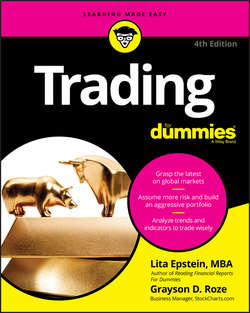Читать книгу Trading For Dummies - Lita Epstein - Страница 9
На сайте Литреса книга снята с продажи.
Part 1
Getting Started with Trading
Chapter 1
The Ups and Downs of Trading Stocks
Taking Time to Trade More Than Just Stocks
ОглавлениеThe ways traders trade are varied. Some are day traders, while others are swing traders and position traders. Although many of the tools they use are the same or similar, each variety of trader works within differing time frames to reach goals that are specific to the type of trades they’re making.
Position trading
Position traders use technical analysis to find the most promising stock trends and enter and exit positions in the market based on those trends. They can hold positions for just a few days, a few months, or possibly as long as a year or more. Position trading is the type of trading that we discuss the most in this book. After introducing you to the stock markets, the types of brokers and market makers with whom you’ll be dealing, and the tools you need, we discuss the basics of fundamental analysis and technical analysis to help you become a better position trader.
Short‐term swing trading
Swing traders work within much shorter time frames than position traders, rarely holding stocks for more than a few days and looking for sharp moves that technical analysis uncovers. Even though we don’t show you the specifics of how to become a swing trader, we nevertheless discuss the basics of swing trading and its strategies in Chapter 17. You can also read about the basics of technical analysis and money‐management strategies, both of which are useful topics to check out if you plan to become a swing trader. However, you definitely need to seek additional training before deciding to pursue this style of trading – reading Swing Trading For Dummies by Omar Bassal, CFA (Wiley), would be a good start.
Day trading
Day traders never leave their money in stocks overnight. They always cash out. They can trade into and out of a stock position in a matter of hours, minutes, or even seconds. Many outsiders watch day traders in action and describe it as more like playing a video game than trading stocks. We discuss this high‐risk type of trading in Chapter 18, but we don’t show you the specifics of how to do it. If day trading is your goal, this book will only take you part of the way there. You discover the basics of technical analysis, but you need to seek out additional training before engaging in this risky trading style – check out Day Trading For Dummies by Ann C. Logue, MBA (Wiley).
WEATHERING A CHANGING MARKET
Housing stocks crumbled in the housing crunch. Financials were crushed in the credit crisis.
We can’t claim any special foresight or knowledge to know when a stock is about to take a big plunge. We don’t have a crystal ball. But we’ve been able to keep most of our money safe from the ravages of the down market since 2008. By using strategies that we discuss throughout this book, we can exit positions before giving back most of our accumulated profits – while many others unfortunately do just that.
An impending pullback is not illuminated with flashing beacons. There is no instant indicator telling us that it’s time to sell everything. Instead, we close individual positions as each stock’s technical conditions deteriorate. The tools we describe in this book enable us to recognize when risk levels have changed, when few stocks are attractive, and when simply leaving most of our trading capital in cash is the best course of action.
Getting credit in 2017 is much easier than it was 2009, but recovery from the housing crash in 2008–2009 is still weak. The stock market, on the other hand, has climbed. For example, the Dow Jones Index was at 8,000 in 2009 and topped 21,000 in 2017. Many traders and analysts expect another correction. We will weather this market with the majority of our trading capital intact as we take profits. Then we may make a little money by shorting a few stocks or buying some short or double‐short exchange‐traded funds. Thanks to the tools we show you in this book, we will be ready to trade aggressively when the technical condition of stocks begins improving again.
